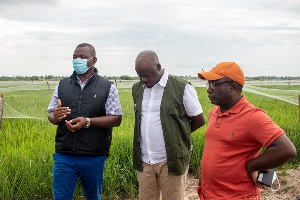Opinions of Monday, 1 November 2021
Columnist: Bashiru Musah
How do we build on the gains made so far to eradicate hunger?
In the past three months, food prices in Ghana have shot up, a rise that the Minister for Agriculture, Dr. Owusu Afriyie Akoto, attributes to a drought in 2020, leading to the underproduction of staple foods like maize.
In a media interview, Dr. Akoto noted that the country has experienced droughts at least once every five years for the past six decades, and that food prices typically go up every year from August to September.
While the honorable minister expressed optimism that the prices will normalize in January 2022, the current situation has drawn attention to our need for resilient food systems that provide adequate food for everyone all year round – a key resolution of the UN Food Systems Summit (UN FSS), in New York, the USA, last month.
Immediately before the UNFSS, AGRA participated in the AGRF Summit in Nairobi, Kenya, where it launched the Africa Agriculture Status Report 2021 (AASR21). The AASR showed that sub-Saharan Africa has registered the most rapid rate of agricultural growth of any region in the world since 2000.
It, however, added that the region remains largely food insecure, accounting for one-third of 256 million of the world’s 795 million hungry people.
In response, the AGRF Summit concluded with a declaration that addressed the matters of first concern for Africa, underscoring a new understanding of food systems and the criticality of food and agriculture in the continent.
All these activities are part of AGRA’s priorities and activities in its 11 focus countries. In Ghana, to support the country’s food systems, AGRA partners with the government in identifying capacity gaps and supporting the implementation of evidence-based interventions that accelerate the country’s agricultural transformation.
We are also keenly promoting policies that incentivize and de-risk private sector participation in the agricultural sector contributing to enhanced access to finance, and the development of active and stable markets for smallholder farmers. This is in addition to driving the adoption of climate-smart technologies and the optimal use of yield-enhancing technologies including high-quality seed and regenerative agriculture.
We are pleased to note the government and civil society support for these initiatives. On World Food Day, on October 16, we saw increased appeals for more food system investments including the better management of food loss and waste and a greater emphasis on environmental sustainability and enhanced food quality.
This is especially after the COVID-19 pandemic exposed the fragility of our food systems to external shocks and highlighted the need to build more resilient food systems and strengthen the resilience of actors in our food chains.
Going forward, and as we seek to reform our food systems to achieve lasting change, we now know that we must continue engaging governments, which hold the authority to ensure that agricultural research, development, and extension systems receive a significant share of total public expenditures, given their centrality in raising agricultural productivity – a key recommendation of the AASR 2021.
Additionally, smallholder farmers must be trained and encouraged to increase food production, through techniques that do not leave adverse effects on the environment. This is in line with the recommendations of the New York Food Systems Summit recognizing the potential nutritional benefits of diverse foods and food systems, and the need to reduce demand-driven pressures globally while ensuring food security in all its dimensions.
Finally, we are also looking to be part of the development of food systems that are inclusive, promoting the participation of youth and women in meaningful economic opportunities along different value chains.
Entertainment










